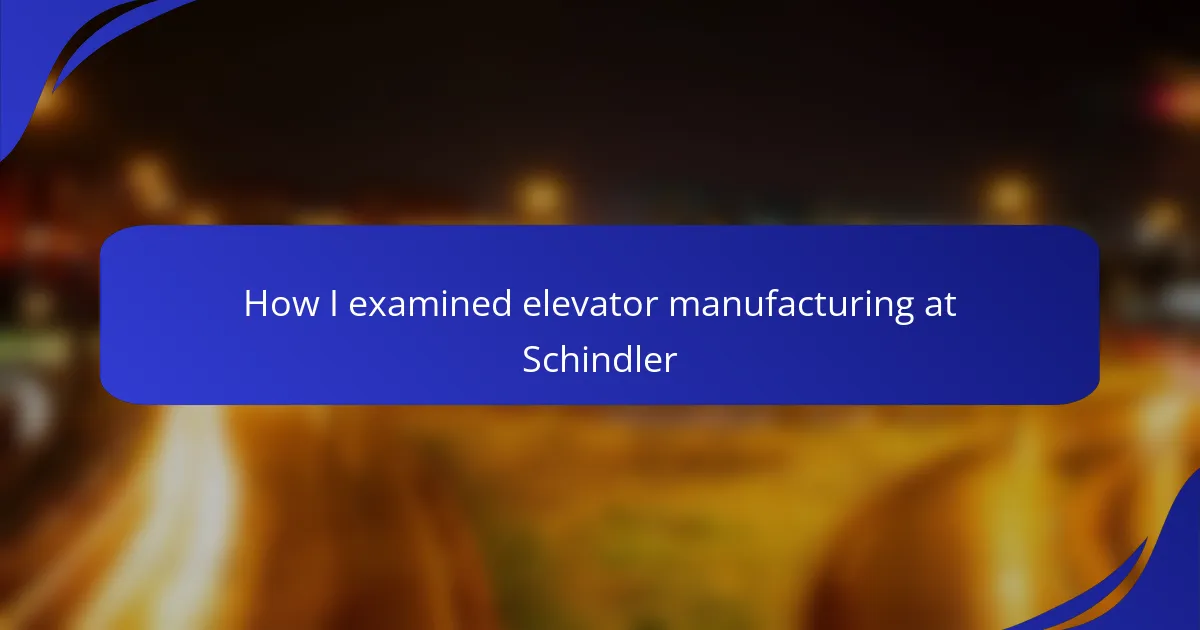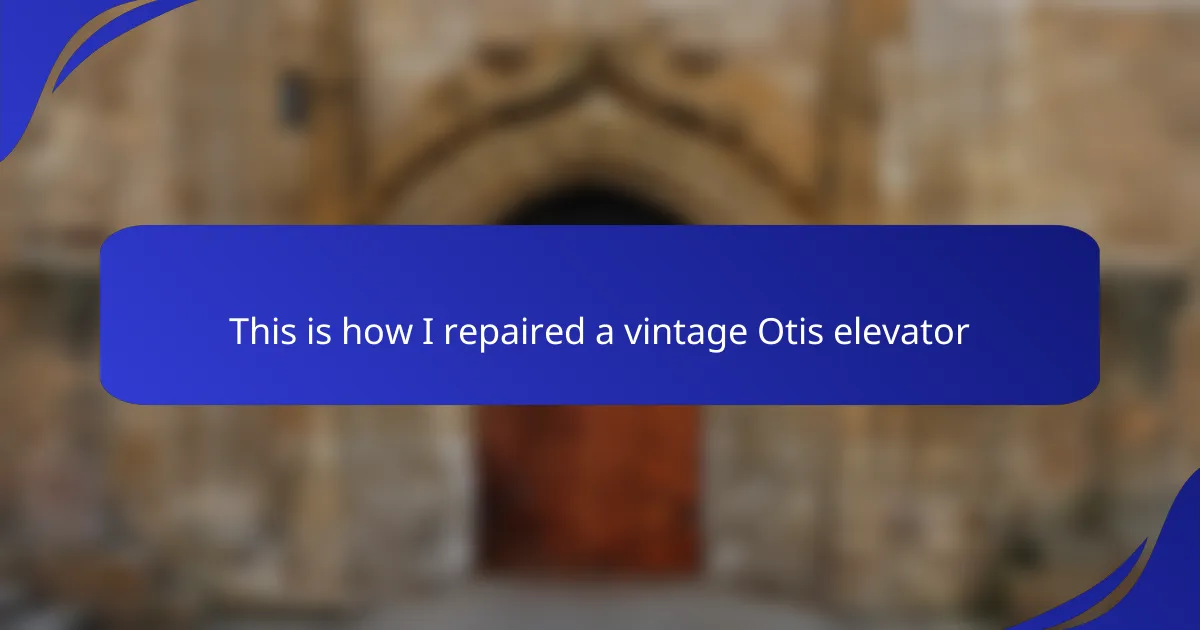Key takeaways
- The elevator industry has evolved from steam-powered models in the 19th century to advanced, energy-efficient systems today, emphasizing the importance of safety regulations.
- Historical accidents led to stringent regulations, with key safety codes established by organizations like ASME to protect users.
- Compliance with local and national safety standards is crucial for preventing accidents and ensuring the safety and trust of users.
- Practical strategies for compliance include staying informed about regulations, thorough documentation, engaging with experts, and continuous training for staff.
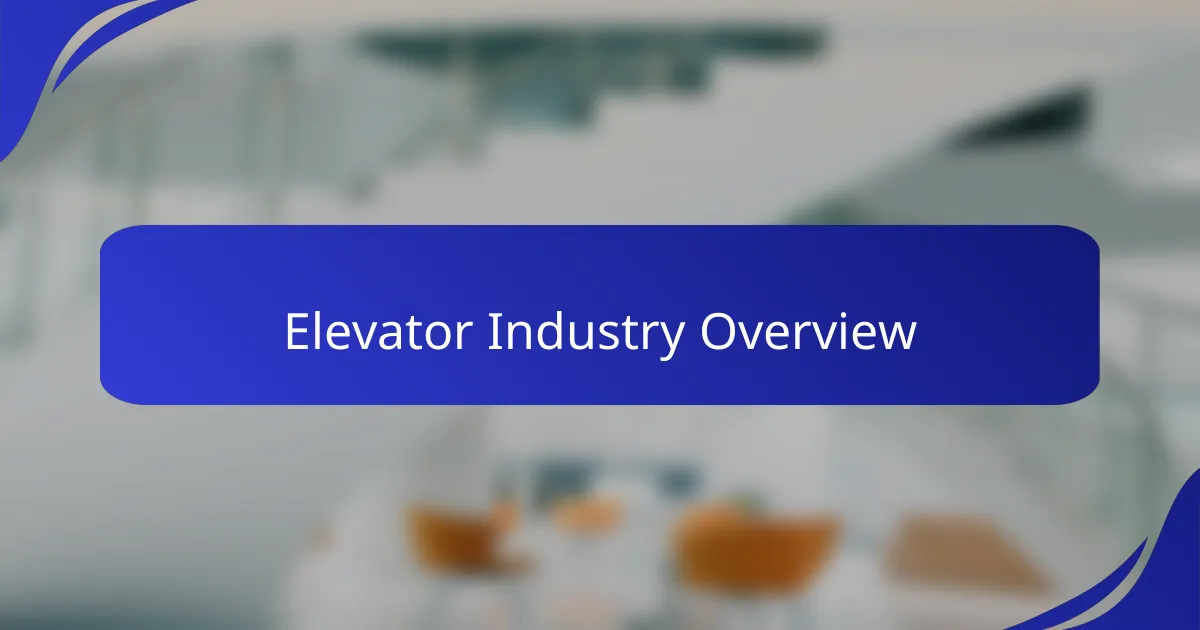
Elevator industry overview
The elevator industry has undergone significant transformations since its inception. From the first steam-powered elevators in the 19th century to the advanced, energy-efficient models we see today, I find it fascinating how far we’ve come. Reflecting on my early days in the industry, I remember being in awe of the complex mechanics behind these systems, which not only transport people but also influence architectural design.
Regulations in the elevator industry are essential for ensuring safety and efficiency. Having navigated these regulations myself, I often felt overwhelmed by the sheer volume of codes and standards. However, I learned that keeping up with these rules is not just a legal requirement; it fosters a culture of safety that ultimately protects everyone.
- Elevators were first introduced in the mid-19th century.
- Modern elevators utilize advanced technology, including smart controls and energy-efficient designs.
- Safety regulations vary by country, but most focus on mechanical safety, emergency protocols, and maintenance standards.
- The American Society of Mechanical Engineers (ASME) establishes key safety codes for elevators.
- Continuous maintenance and modernization are critical to meet evolving technology and safety standards.
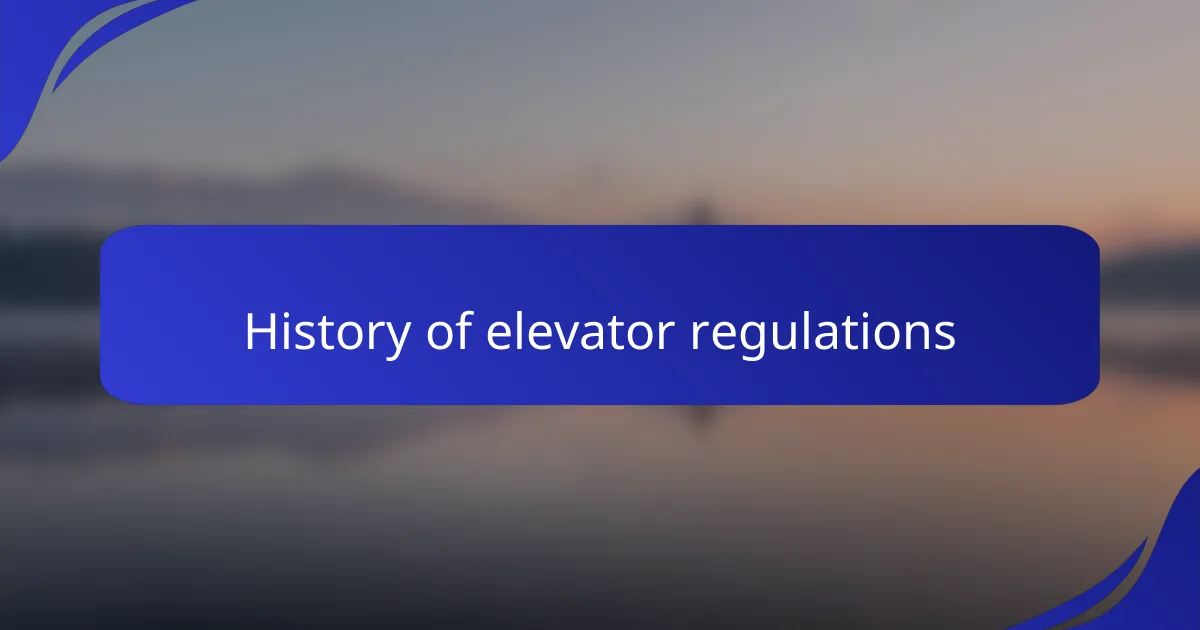
History of elevator regulations
The history of elevator regulations is deeply intertwined with the evolution of elevator technology and safety standards. I remember the first time I stood in a towering building, feeling a mix of excitement and trepidation as I ascended. It wasn’t until later that I learned about the stringent regulations that have developed over time, starting from the late 19th century when elevators began to emerge as a popular mode of transport in skyscrapers.
Initially, safety was a secondary concern until a series of tragic accidents, such as the 1914 collapse of a New York City elevator that claimed lives, prompted lawmakers to implement stricter measures. Over the years, organizations like the American Society of Mechanical Engineers (ASME) established codes that shape today’s regulations, ensuring that elevators are safe for users like you and me.
- In 1861, the first safety elevator was patented by Elisha Otis, which marked the beginning of safety-focused regulations.
- The first major code for elevators, ASME A17.1, was published in 1921, outlining safety requirements and standards.
- The U.S. National Elevator Industry, Inc. (NEII) was established in 1981 to advocate for increased safety standards and regulations.
- In the late 20th century, building codes became more rigorous, leading to improved safety features like emergency brakes and phone systems in elevators.
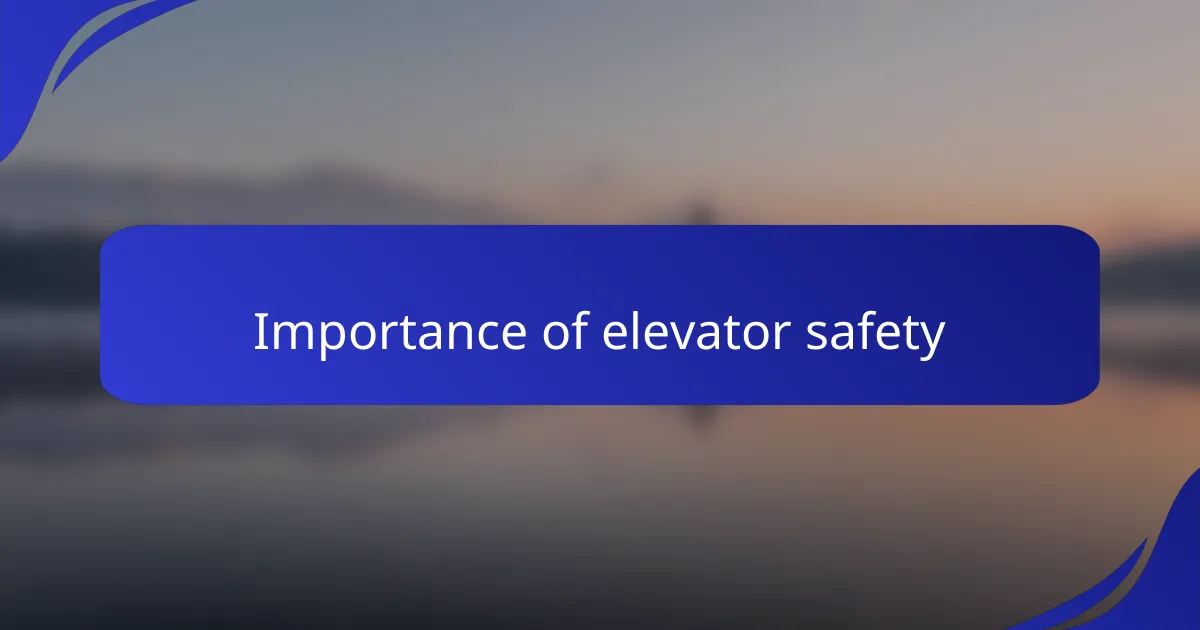
Importance of elevator safety
Ensuring elevator safety is paramount in protecting not only the lives of users but also the reputation of the elevator industry. I remember my first week on the job, where a routine safety inspection turned into a valuable lesson. A worn cable was discovered, which could have led to catastrophic consequences had it gone unnoticed. This experience cemented my belief that prioritizing safety isn’t just good practice; it’s a moral obligation.
Elevators are intricate machines that require strict adherence to regulations and maintenance protocols. Any oversight can result in injuries or fatalities, affecting families and communities deeply. Here are some key considerations for elevator safety:
- Regular inspections and maintenance are crucial to identify potential hazards.
- Compliance with local and national safety regulations helps prevent accidents.
- Equipping elevators with up-to-date safety features ensures user protection.
- Providing comprehensive training for staff enhances emergency response readiness.
- Public awareness campaigns can educate users on safe elevator practices.
Every effort toward safety creates a ripple effect, improving overall trust in the system. I often remind my team that behind every elevator operation, there are lives at stake.

Key elevator laws and standards
Navigating elevator law regulations can feel like traversing a labyrinth. I remember when I first delved into this complex web of rules; it was both overwhelming and enlightening. Understanding key laws and standards not only ensures safety but also helps instill confidence in users. For instance, the National Elevator Industry, Inc. (NEII) plays a pivotal role in advocating for safety standards and codes, which, when followed, reduce risks significantly.
Over time, I’ve learned that being well-versed in these laws is essential for any professional in the elevator industry. Here are some important standards to keep in mind:
- ASME A17.1: The Safety Code for Elevators and Escalators, which outlines design and construction requirements.
- ADA Compliance: Ensures that elevators are accessible for individuals with disabilities, fostering inclusivity.
- Local Building Codes: Every region often has specific regulations that dictate installation and maintenance standards.
- Inspection Requirements: Regular inspections are mandated to ensure ongoing safety and performance.
- Emergency Operations: Guidelines for how elevators operate during power failures and emergencies, ensuring passenger safety.

Challenges in navigating regulations
Navigating elevator regulations can often feel like wading through an overwhelming sea of rules, especially when I first stepped into this field. I remember combing through layers of intricate codes and standards, occasionally asking myself, “How can anyone keep track of all this?” The challenge isn’t just the volume of regulations; it’s also understanding how each one applies in real-world scenarios, which can vary significantly based on location and technology.
One of the most significant hurdles I’ve faced is ensuring compliance with local building codes while also adhering to national standards like those from ASME. For instance, I once encountered a situation where differing standards clashed during a renovation project, leaving us in a bind. It forced me to reach out to experts and do extensive research to clarify which regulations took precedence. This experience taught me that diligence is crucial and that collaboration with knowledgeable counterparts can turn challenges into learning opportunities.
Moreover, keeping abreast of evolving safety standards is a daunting task in itself. The pace at which technology advances often calls for updated regulations, and missing a change can lead to non-compliance. I vividly remember the anxiety I felt when a new emergency protocol was announced shortly after I had completed a project. It underscored how vital it is to stay informed and adaptive in an industry where the stakes are so high.

Personal experiences with elevator law
Experiencing elevator law firsthand has often left me feeling like I’m navigating a dense jungle of codes and statutes. I recall a moment during a compliance audit when I discovered discrepancies in the documentation. I felt a wave of panic wash over me: “What if this oversight risks someone’s safety?” This encounter underscored how critical attentiveness is in our field—small errors can have significant consequences.
One memorable experience was during a project where we had to upgrade an older building’s elevators to meet modern safety standards. As I sifted through the state and local regulations, I often wondered, “How do others manage it all?” I reached out to colleagues for insights, which brought a sense of camaraderie and shared purpose. This collaboration not only eased the burden but also sparked enriching discussions about best practices.
The emotional weight of responsibility in this industry can be intense. I remember a particular incident involving a routine inspection when I realized that a minor issue, if left unaddressed, could escalate into a safety hazard. It was an eye-opening moment that reflected just how much our diligence pays off. The weight of ensuring safety for every individual who steps into an elevator is a profound reminder of why we must stay vigilant and committed to navigating these laws effectively.

Tips for compliance success
Navigating elevator law regulations can often feel overwhelming. I remember when I first plunged into this maze of rules; it was both daunting and enlightening. Each experience taught me the importance of thorough research and staying updated on local codes, and I quickly realized that attention to detail would save me a lot of headaches down the line.
To ensure compliance success, here are some practical tips I’ve gathered along the way:
- Stay Informed: Regularly check for updates on regulations in your area; laws can change more often than you might think.
- Document Everything: Keep thorough records of inspections, maintenance, and repairs. This creates a safety net during audits or inspections.
- Engage with Experts: Build relationships with local code inspectors or elevator engineers; their insights can be invaluable for navigating complex regulations.
- Train Your Team: Make sure that everyone involved in elevator operations understands the regulations and the significance of compliance.
- Review and Revise: Periodically revisit your compliance strategies to ensure they are effective and in line with current laws.

